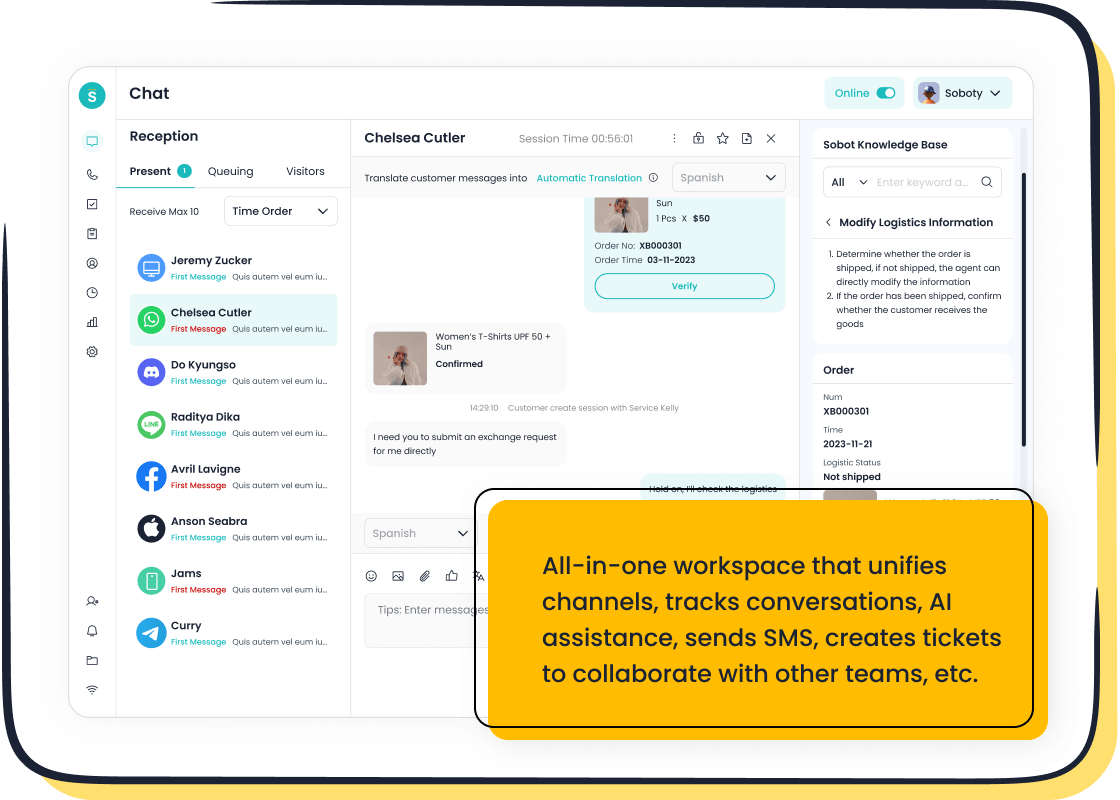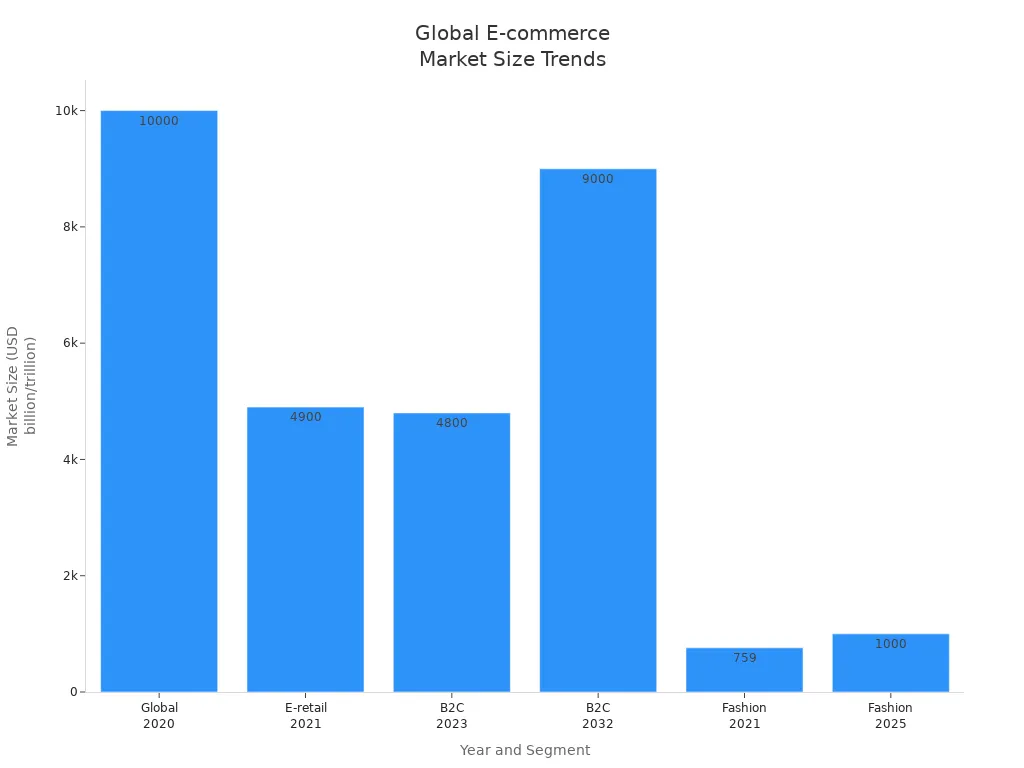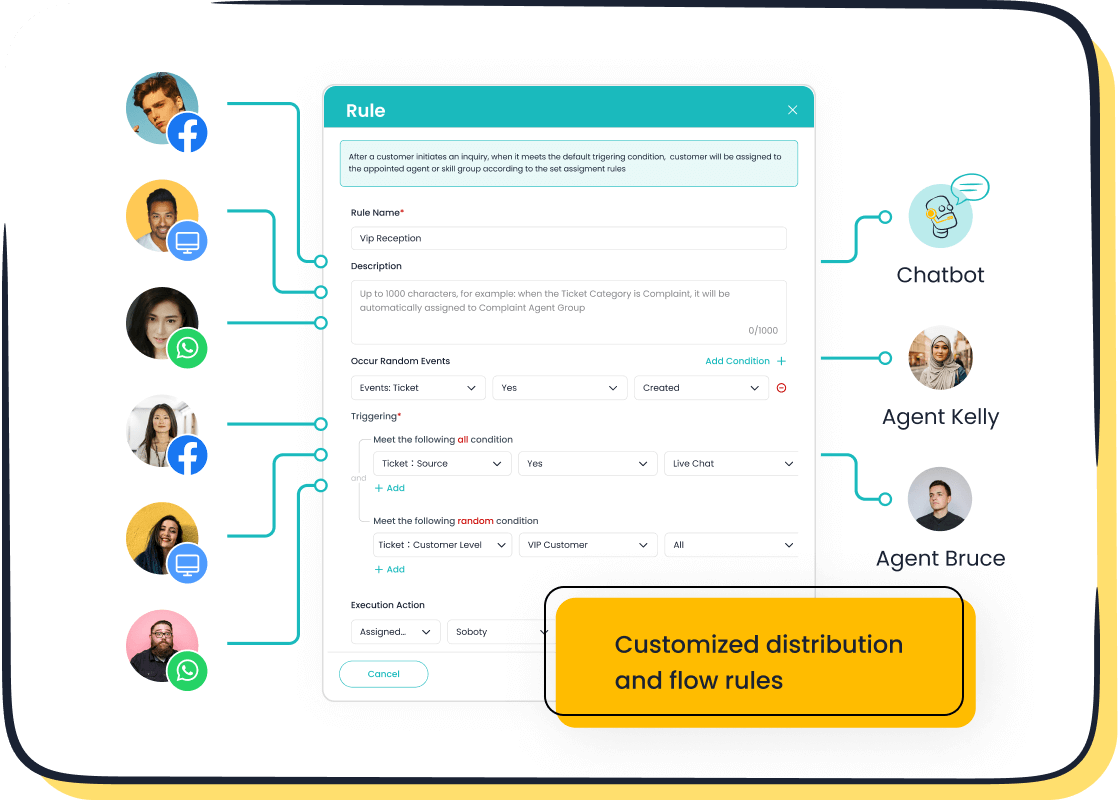Unlocking E-commerce and Customer Service Success in 2025

E-commerce and customer service success in 2025 will depend on how well you anticipate and meet rising customer expectations. Innovation drives every interaction, as shoppers want fast, convenient, and personalized service across all channels. The global e-commerce market keeps growing, with projections showing a B2C market size of $9 trillion by 2032.
| Statistic Description | Value/Projection | Source |
|---|---|---|
| Global e-commerce market size in 2020 | Exceeded $10 trillion | Grand View Research |
| Projected CAGR (2020-2027) | 14.7% | Grand View Research |
| Expected B2C market size by 2032 | $9 trillion | CMSWire |

You need to use proactive updates, AI-driven support, and personalized recommendations to deliver exceptional customer service. Sobot, Sobot AI, and the Sobot call center help you create seamless experiences that build loyalty in the competitive e-commerce landscape.
E-commerce and Customer Service Trends
Personalization
You see personalization shaping the future of ecommerce customer service. Brands use customer data to create tailored experiences, making each shopper feel valued. When you receive product recommendations based on your browsing history or get emails with your name, you experience personalization in action. This approach helps ecommerce businesses stand out and encourages you to return. Studies show that 81% of customers appreciate brands that tailor experiences to their needs. Personalized emails achieve higher open and click-through rates, while product recommendations can boost revenue by up to 26%. You benefit from segmented marketing campaigns, which increase conversion rates by 50%. Personalization strategies lead to a 20% increase in sales and a 15% rise in customer retention. When you feel understood, you are more likely to stay loyal and make repeat purchases.
Tip: Personalized interactions make you feel special and increase your satisfaction with ecommerce customer service.
Omnichannel Support
E-commerce and customer service now rely on omnichannel support to meet your expectations. You want help on your favorite platforms, whether you shop on a website, use a mobile app, or connect through social media. Leading ecommerce brands implement unified customer support across channels, ensuring seamless transitions and consistent policies. You can chat with support agents, use AI chatbots, or access self-service options. Mobile commerce continues to grow, with responsive websites and user-friendly apps making shopping easier. Social commerce strategies, such as shoppable posts and live streaming, expand your choices. Automation tools help manage customer interactions efficiently, providing personalized responses and freeing up staff for complex issues. Brands optimize omnichannel support by analyzing data, gathering feedback, and training staff to maintain high service quality.
| Omnichannel Support Strategies | Benefits for Customers |
|---|---|
| Unified support across channels | Seamless experience |
| AI chatbots & self-service | Fast assistance |
| Mobile commerce optimization | Convenience |
| Social commerce integration | More engagement |
| Automation tools | Efficient support |
AI Integration
AI integration transforms ecommerce customer service by making support faster and smarter. You get instant answers from AI-powered chatbots and virtual assistants, available 24/7. AI automates repetitive tasks, reducing wait times and operational costs. When you ask a question, AI analyzes your data to deliver personalized, context-aware support. It manages support tickets by categorizing and routing issues quickly, giving you real-time updates. Generative AI adapts its tone to match your mood, improving satisfaction. Human agents focus on complex queries, while AI handles basic ones. Businesses use AI-driven insights to optimize strategies and improve customer experience. As AI agents learn, they reduce escalation rates and improve key metrics like First Response Time. You benefit from faster, more accurate support and a personalized experience every time you interact with ecommerce customer service.
Importance of Ecommerce Customer Service
Customer Loyalty
You build strong relationships with your customers when you focus on high-quality ecommerce customer service. Customers feel valued when you offer personalized support and make their shopping experience easy. You see loyalty grow when you use social customer relationship management strategies and recommender systems. These tools help you create trust and satisfaction.
- High-quality service increases perceived value and satisfaction, which leads to greater customer retention.
- Personalized content and fast support encourage repeat purchases and long-term relationships.
- Customers trust brands that offer transparency and easy navigation, boosting satisfaction and loyalty.
- Enjoyable interactions and efficient service make customers want to return.
- Online staff services, like live chat, help you build emotional connections and improve customer retention rate.
Tip: When you make every customer feel special, you increase satisfaction and loyalty, which helps your business grow.
Conversion Rates
You improve your ecommerce conversion rate optimization by delivering excellent e-commerce customer service. Customers respond quickly to abandoned cart emails, especially when you send them within 30 minutes. Incentives like discounts or free shipping boost conversion rates. Segmented email campaigns based on customer behavior lead to higher engagement and more sales.
Retailers with omnichannel support see higher conversion rates than those without. Trust signals and security features reduce buyer anxiety, making customers more likely to complete purchases.
| Strategy | Impact on Conversion Rate |
|---|---|
| Abandoned cart emails | Recover lost sales |
| Incentives (discounts, shipping) | Boost conversions |
| Segmented campaigns | Higher click rates |
| Omnichannel support | Increased conversions |
| Trust signals | Lower buyer anxiety |
Brand Reputation
You shape your brand reputation through every customer interaction. Positive ecommerce customer service experiences create emotional bonds, leading to higher lifetime value and more referrals. Customers who feel connected spend more and buy more often.
Almost 80% of customers consider your service reputation before making a purchase. Over 70% end relationships with companies that provide poor service. Immediate responses and enjoyable experiences matter more than speed or agent knowledge.
Exceptional service on a first purchase makes a second purchase almost certain. Customers forgive mistakes if you provide excellent support.
You build relationships and trust by offering friendly, knowledgeable, and empathetic service. This approach boosts satisfaction, retention, and customer relationships, making your brand stand out in the ecommerce market.
Challenges in E-commerce Customer Service

Rising Expectations
You face rising expectations from customers every year. In 2025, shoppers want fast, reliable, and personalized service. Over 90% of U.S. shoppers say customer service helps them decide where to shop. When you deliver a positive experience, 93% of customers return for future purchases. Customers expect updates after every order, including shipping and tracking notifications. If you miss these updates, satisfaction drops. You must offer support through chatbots, live agents, and helpful content. Customers want you to solve problems quickly and provide clear answers. You need to balance automation with human interaction to keep satisfaction high. Customers also expect you to protect their privacy and use their data responsibly. If you meet these expectations, you build trust and loyalty.
Note: Customers in 2025 expect proactive service. You should use technology to predict needs and solve issues before they happen.
Multichannel Demands
You must manage customer support across many channels. Customers reach out through websites, apps, social media, email, and messaging platforms. Over half of shoppers feel companies do not provide consistent service across channels. Only a small number of businesses have a unified view of customer data. This makes it hard for you to deliver seamless experiences. Customers get frustrated when they repeat information or receive different answers on each channel. You need to train staff and invest in technology to centralize interactions. Managing multiple channels requires resources and planning. You must prioritize channels that matter most to your customers. Using AI and automation can help you improve efficiency and satisfaction.
| Common Multichannel Challenges | Impact on Customers |
|---|---|
| Inconsistent service | Frustration |
| Fragmented data | Impersonal support |
| Repeated information | Lower satisfaction |
| Slow response times | Lost trust |
Automation vs Human Touch
You use automation to handle routine tasks and provide 24/7 support. Automation saves costs and helps you scale as your business grows. Customers like quick answers and real-time responses. However, some customers prefer talking to a human, especially for complex or emotional issues. Automation can sometimes miss the context or fail to show empathy. You need to balance automated systems with human agents. Use automation for simple questions and let humans handle difficult cases. Set up clear options for customers to reach a person when needed. Analyze feedback to improve your chatbots and workflows. Combining automation with human touch increases customer satisfaction and loyalty.
-
Benefits of Automation:
- Cost savings
- Fast, consistent responses
- Scalability
- Improved data analytics
-
Challenges of Automation:
- Lack of empathy
- Integration issues
- Customer frustration if automation fails
Tip: Always give customers an easy way to talk to a human agent. This keeps satisfaction high and builds trust.
Improve Ecommerce Customer Experience
Customer-Centric Culture
You build a strong ecommerce customer experience when you put your customers at the center of every decision. A customer-centric culture means you listen to feedback, understand needs, and make changes that benefit your shoppers. You see companies like Adobe and Southwest Airlines thrive because they focus on customer satisfaction and loyalty. Leadership commitment drives this culture, making sure everyone in your business values customer relationships.
When you provide consistent, fast, and accurate service across all channels, you build trust. You encourage word-of-mouth marketing and repeat business by making every interaction positive. Surveys and KPIs help you tailor your customer service strategy and improve satisfaction. You reduce customer effort during the checkout process, which leads to higher retention and better experiences.
Tip: Hire empathetic, tech-savvy staff to improve customer service and build lasting relationships.
You can learn from successful brands:
- ZARA streamlines operations to make shopping easier.
- Amazon anticipates needs with proactive service.
- Dropbox uses customer feedback to fuel innovation.
Customer-centric companies are 60% more profitable than others. If your CEO focuses on customers, your business is 64% more likely to outperform competitors. Improving customer retention by just 2% can have the same effect as cutting costs by 10%. Treating customer service as a value center helps you grow revenue 3.5 times faster. Over half of customers leave after one poor experience, so every interaction matters.
To embed customer-centricity, you must align people, processes, and technology. Cultivate relationships instead of just transactions. Use CRM systems to unify customer data and deliver personalized service. Link your culture to measurable outcomes, like satisfaction scores and retention rates. Overcome barriers such as fragmented data and resistance to change to succeed in ecommerce.
Data Analytics
You improve ecommerce customer experience by using data analytics to understand your shoppers. Behavioral analytics track page views, clicks, and browsing patterns, helping you see what interests your customers. Transactional analytics show purchase history and payment methods, revealing sales trends and high-value customers. Engagement analytics measure interactions across social media, emails, and customer service channels, giving you insight into satisfaction and loyalty.
You segment customers by age, gender, and income using demographic analytics. This enables targeted marketing and personalized recommendations. Predictive analytics use machine learning to forecast customer behavior and trends, allowing you to improve customer service before issues arise.
Here are ways data analytics enhance ecommerce customer experience:
| Type of Analytics | How It Improves Customer Experience |
|---|---|
| Behavioral | Understand interests, personalize offers |
| Transactional | Identify trends, reward loyal customers |
| Engagement | Measure satisfaction, improve interactions |
| Demographic | Target marketing, customize communication |
| Predictive | Forecast needs, prevent problems |
You use real-time analysis to recover abandoned carts by sending personalized messages or discounts. Automated tools create SEO-friendly product descriptions and dynamic marketing content. Conversational AI chatbots, powered by analytics, provide detailed and personalized support. Session replays and heatmaps help you spot pain points in the checkout process, making it easier for customers to complete purchases.
Note: Data-driven decisions help you improve customer service, boost retention, and increase conversion rates.
You collect data from mobile apps, purchase histories, surveys, and website engagement. These insights let you optimize marketing, reduce churn, and improve the checkout process. You focus on loyal customers to increase retention and use analytics to make every experience better.
Service Level Agreements
You set clear expectations for your customers by using service level agreements (SLAs). SLAs define measurable performance metrics, such as response times, order fulfillment rates, and uptime percentages. This helps you manage customer expectations and reduce misunderstandings. SLAs foster accountability by holding service providers responsible for meeting agreed-upon standards, building reliability and trust.
You include defined issue resolution processes with specific timelines, enabling rapid problem-solving. This minimizes disruptions and enhances the ecommerce customer experience. Regular reporting on key performance indicators promotes transparent communication and keeps customers informed. Flexibility in SLAs allows you to adapt to changing business needs and customer demands, ensuring continued relevance and satisfaction.
Continuous improvement clauses in SLAs show your commitment to enhancing service quality over time. In ecommerce, SLAs help ensure timely order fulfillment, prompt customer support, and seamless operations. These factors contribute to improved customer satisfaction and retention.
Here are the main benefits of SLAs in ecommerce:
- Timely order delivery and prompt support
- Improved operational efficiency through performance tracking
- Stronger vendor relationships based on trust and accountability
- Reduced risks and disputes with clear expectations
- Compliance with industry standards and legal requirements
You face challenges such as changing customer expectations and vendor performance issues. Automation helps you track and report SLA metrics, making it easier to maintain high standards. SLAs play a key role in your customer service strategy, helping you deliver a reliable and satisfying ecommerce customer experience.
Tip: Review and update your SLAs regularly to keep up with customer needs and market changes.
Tools and Solutions for E-commerce Customer Service

Modern e-commerce businesses rely on advanced tools and solutions to deliver outstanding customer support and improve customer experience. You need platforms that help you manage conversations, automate tasks, and provide instant help across every channel. Let’s explore the leading solutions and best practices for ecommerce customer service in 2025.

Sobot Live Chat
Sobot Live Chat stands out as a top choice for ecommerce customer experience. You use it to connect with customers instantly on their preferred channels, including websites, apps, WhatsApp, Facebook, Instagram, Telegram, and Discord. Sobot’s unified workspace lets you track every conversation, manage tickets, and access customer data in one place. This approach helps you improve customer service and boost conversion rates.
You benefit from Sobot’s AI-powered tools, which handle up to 70% of routine queries. This frees your agents to focus on complex issues. Sobot Live Chat supports multilingual communication, so you can serve global customers without hiring large teams. The platform’s built-in analytics evaluate over 150 indicators, helping you optimize your support strategy and make data-driven decisions.
Here’s how Sobot Live Chat compares to other leading solutions:
| Tool | Key Features | Pricing (USD) | Best For | Notable Customer Outcomes |
|---|---|---|---|---|
| Sobot Chatbot | AI-driven sentiment analysis, real-time insights, multilingual support, omnichannel integration | Starting at $30/month for SMBs; custom enterprise solutions | Retail, ecommerce, finance, gaming | 40% cost reduction (Klarna), 43% ticket deflection (Motel Rocks), 83% resolution rate (OPPO), 95% customer satisfaction |
| Brandwatch Cortex | Social media monitoring, brand sentiment tracking, comprehensive analytics platform | Pro: $500/month; Enterprise: $1,000/month | Large enterprises, social media-focused brands | Great for in-depth social media monitoring and analytics |
| Chattermill | Unified customer feedback analysis, actionable insights, multi-channel support | Custom quote required | Telecom, customer experience teams | 25% increase in positive feedback, improved NPS scores |
| Lexalytics | Industry-specific customization, multilingual analysis, deep language processing | Custom quote required | Hospitality, retail, enterprise | Helped hotels enhance guest experiences through tailored solutions |
Sobot Live Chat’s affordable pricing and scalable features make it accessible for small businesses and large enterprises. You see measurable results, such as a sixfold increase in customer service efficiency for Agilent and an 83% resolution rate for OPPO. Klarna reduced costs by 40%, and Motel Rocks deflected 43% of tickets using Sobot’s AI chatbot. These outcomes show how Sobot helps you improve customer support and drive business growth.
Tip: Sobot Live Chat offers a free trial, so you can test its features before making a commitment. Visit Sobot Live Chat for more details.
AI-Powered Support
AI-powered support transforms the way you manage ecommerce customer experience. You use AI chatbots, predictive analytics, and automated notifications to anticipate customer needs and provide fast, relevant help. Automation of routine tasks reduces manual workload and unnecessary escalations, improving your team’s efficiency.
You gain several benefits from AI-powered support:
- Proactive support shifts your approach from reacting to problems to anticipating them.
- Automation lowers operational costs and reduces ticket volume.
- Personalized support enhances customer loyalty and sets you apart in a competitive market.
- AI tools like chatbots, sentiment detection, and smart self-service portals improve customer experience and operational metrics.
You see increased productivity because AI handles repetitive tasks, freeing your agents to focus on complex issues. First-call resolution rates improve, and you provide 24/7 multilingual support without needing large teams. Fast response times and proactive engagement lead to higher customer lifetime value and better return on investment.
Sobot AI offers a comprehensive platform for ecommerce customer service. You integrate chat, email, voice, and social media into one system. Sobot’s AI agents deliver human-like interactions, while AI copilots assist agents with response generation and summaries. Real-time insights from AI analytics help you optimize workflows and improve service strategies. Sobot AI supports GDPR compliance and data encryption, so you can trust your customer data is secure.
Note: Sobot AI helped Weee!, America’s largest online Asian supermarket, increase agent efficiency by 20% and reduce resolution time by 50%. The customer satisfaction score reached 96%. Learn more about Sobot AI at Sobot AI Solution.
Omnichannel Platforms
Omnichannel platforms unify all your customer interactions into a single system. You provide seamless support across websites, apps, social media, email, and phone. Customers never need to repeat information, which increases satisfaction and loyalty. Personalized interactions based on tracked customer data boost engagement and conversion rates.
Here are the main ways omnichannel platforms improve ecommerce customer experience:
- Omnichannel support eliminates repetition, leading to higher satisfaction and loyalty. Studies show that 89% of customers are more likely to repurchase after positive service.
- Personalized interactions increase engagement and conversion rates.
- Real-time engagement across channels drives more conversions and revenue growth.
- Centralized customer data provides better insights, enabling continuous service improvement.
- Proactive and 24/7 support reduces wait times and addresses customer needs before they arise.
- Seamless transitions between channels ensure a continuous customer journey without loss of context.
- Continuous feedback loops help you identify service gaps and optimize the customer experience.
Sobot’s omnichannel platform lets you manage all customer support channels in one workspace. You automate request routing, reduce processing times, and minimize communication errors. You create personalized experiences by leveraging customer data, making each customer feel valued and understood. Sobot’s platform anticipates customer needs through data analysis, providing proactive service that builds trust and loyalty.
You see smooth transitions between channels, so customers enjoy a continuous and comfortable journey. Brands like Nike, Amazon, and Sephora use omnichannel strategies to increase loyalty, average order size, and long-term relationships. Sobot’s platform helps you deliver seamless, personalized, and efficient support, improving ecommerce customer experience and driving business success.
| Tool | Key Features | Pricing Range | Pros | Cons | Suitable For | Notable Clients |
|---|---|---|---|---|---|---|
| Zendesk | Multichannel support, ticketing system, knowledge base, AI automation, analytics | €19 to €169 per month (various plans) | Robust, scalable, customizable | Can be costly, learning curve | Businesses of all sizes needing scalable support | Uber, Shopify, Shell |
| LiveChat | Real-time chat widget, behavior-based triggers, analytics, ticketing | $20 to custom pricing | Instant personalized support, mobile apps, multilingual | Primarily live chat only, needs integration for full ticketing | E-commerce businesses wanting real-time visitor engagement | IKEA, PayPal, Ryanair, Lexus |
| Gorgias | Helpdesk tailored for e-commerce, deep integration with Shopify and Magento | N/A | Specialized for e-commerce platforms | N/A | E-commerce stores on Shopify, Magento | N/A |
| Sobot | Omnichannel support, AI-powered chatbots, unified workspace, analytics, multilingual support | Starting at $30/month | Affordable, scalable, high satisfaction, strong analytics | N/A | Retail, ecommerce, finance, gaming, enterprise | Samsung, OPPO, Weee!, Klarna, Agilent, Michael Kors |
You simplify support workflows by automating repetitive tasks like ticket categorization and assignment. You enhance customer satisfaction through instant communication and real-time ticket status updates. Canned responses, auto-replies, and automated routing reduce response time. You improve agent performance with ticket prioritization, AI assistance, and collaboration features. A centralized knowledge base and self-service portal reduce ticket volume and help customers find answers quickly. As your business grows, these platforms scale to handle more inquiries without losing service quality.
Tip: Integrate all your customer support channels into one omnichannel platform. This best practice for ecommerce customer service helps you deliver consistent, personalized, and efficient support.
Case Study: Sobot and Ecommerce Customer Experience
Weee! Success Story
You can see how Sobot transforms e-commerce customer experience by looking at Weee!, America’s largest online Asian supermarket. Weee! faced challenges with high volumes of customer inquiries, language barriers, and the need for fast, reliable support. To solve these issues, Weee! used several strategies with Sobot:
- You use AI-powered chatbots to answer routine questions, which reduces the workload for your support team.
- You integrate WhatsApp Business API, so customers get instant and personalized responses.
- You combine chatbots and WhatsApp to streamline support, making it faster for customers to get help.
- You work with a user-friendly platform, so your team can adopt it quickly and use it efficiently.
- You automate simple tasks, which lets your team focus on more complex customer needs.
- You engage customers across multiple channels, improving satisfaction through quick and easy communication.
These steps help you deliver a better experience for your customers and make your support team more effective.
Results and Benefits
When you use Sobot, you see measurable improvements in customer service. Weee! increased agent efficiency by 20% and cut resolution time by 50%. Customer satisfaction reached 96%. These results show how Sobot helps you create a positive customer experience.
Here is a table showing key metrics from Sobot’s impact on e-commerce:
| Metric/Benefit | Description/Impact |
|---|---|
| Customer Satisfaction (CSAT) | 96% approval from customers |
| Net Promoter Score (NPS) | 78%, showing strong loyalty |
| Response Time | Less than 24 hours |
| Chatbot Resolution Rate | 83% of queries resolved by chatbot (OPPO case) |
| Efficiency Improvement | Up to 6 times higher |
| Cost Reduction | 25% lower support costs |
| Cart Abandonment Reduction | 30% decrease |

You benefit from Sobot’s AI chatbots, which work 24/7 and give instant, personalized answers. Automation frees your team to handle complex issues. Sobot’s advanced AI, predictive analytics, and multilingual support help you connect with customers in meaningful ways. You can see more details and customer stories on Sobot’s official website.
Note: Sobot’s solutions help you improve customer engagement, increase loyalty, and make your business more efficient.
You can achieve e-commerce customer service excellence in 2025 by following key steps:
- Design intuitive, mobile-friendly websites to engage shoppers.
- Use AI-powered personalization and live chat support, like Sobot Live Chat, for instant help.
- Map the customer journey and empower your support team with training and technology.
- Integrate omnichannel platforms and measure success with metrics like CSAT and NPS.
Embrace customer-centric and technology-driven strategies. When you innovate and put your customers first, you build loyalty and drive long-term growth.
FAQ
What makes Sobot Live Chat effective for e-commerce customer service?
Sobot Live Chat connects you with customers on their favorite channels. You use AI-powered tools to answer questions fast. Built-in analytics help you track over 150 service indicators. You see a 38% gain in conversion and higher customer satisfaction.
How does AI improve e-commerce customer experience?
AI chatbots answer routine questions 24/7. You get instant support and personalized recommendations. AI helps you reduce wait times and improve first response rates. Businesses using AI see up to 50% faster resolution and higher loyalty.
Can Sobot support multiple languages for global e-commerce?
Yes, Sobot offers multilingual support. You serve customers in different regions without hiring large teams. Sobot’s auto-translation feature helps you communicate clearly. Global brands like Weee! use Sobot to reach diverse audiences.
What channels does Sobot Live Chat support?
You connect with customers on websites, apps, WhatsApp, Facebook, Instagram, Telegram, and Discord. Sobot’s omnichannel platform keeps all conversations in one workspace. You never miss a message, and customers get help where they shop.
How do you measure customer service success in e-commerce?
You track metrics like customer satisfaction (CSAT), Net Promoter Score (NPS), response time, and resolution rate. Sobot’s analytics dashboard gives you real-time data. Brands using Sobot report up to 96% CSAT and a 30% drop in cart abandonment.
See Also
Discover The Leading Cloud Contact Centers For 2025
Best Live Chat Solutions For Ecommerce In 2024
Ways Live Chat Software Increases Ecommerce Sales
